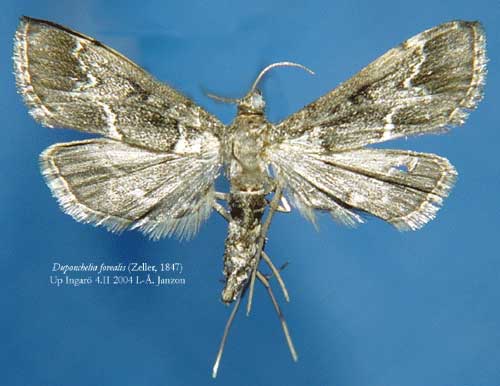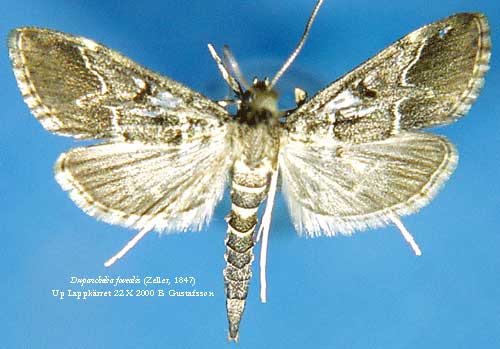
Larva

Adult Female

Adult Male
Received from:
Julieta Brambila
FL/APHIS/USDA
Julieta.Brambila@aphis.usda.gov
This species is NOT established in the United States, but it is being increasingly intercepted at ports of entry and was found in three Canadian locations.
This alert concerns a Lepidoptera pest in peppers (fruit) from the Netherlands. However, the pest is reported to have a broad host range including propagative plant materials. Due to the recent increase in interceptions of this pest from the Netherlands, please be alert to its possible presence in plant shipments from that origin.
Personnel in Boston, MA, U.S., continue to find Duponchelia fovealis at an alarming rate on Dutch peppers . After doing additional research, in 2005 three greenhouses in southern Ontario Canada were confirmed for having this pest which was found on Begonia plants. The moth has a broad host range and can affect crops such as begonia, gerbera, cyclamen, anthurium, kalanchoe, poinsettia, and rose as well as many other crops, including aquatic plants, corn, and greenhouse vegetables such as peppers. Duponchelia is not established in North America and is listed as a pest of quarantine significance.
Canadian Food Inspection Agency PDF on the Biology, Symptoms, Mophology of this species.
On 12/13/05, Dawn Miller-Cormier, Network Specialist in Horticulture with the Canadian Food Inspection Agency [ (902)426-4469 | millercd@inspection.gc.ca| Facsimile/TÚlÚcopieur: (902) 426-4844 ] provided this update:
"The insect is a pyralid moth native to Africa, Asia Minor and the Mediterranean part of Europe. It is polyphagus having a wide host range that includes a number common food and ornamental plants. The insect has been present in the Netherlands for about 15 years and over the past 5-10 it has become established in greenhouses all over that country. The USDA has repeated intercepted the insect on imported shipments - primarily in peppers from Europe. The first North American report of the insect was in 2004 when it was identified in a Californian facility producing begonia. This population has been eradicated. The Canadian Food Inspection Agency confirmed the present of the insect in three Ontario cut flower production facilities in the spring of 2005. It has been eradicated in one facility with eradication efforts continuing in the other two facilities."


Adult Female

Adult Male